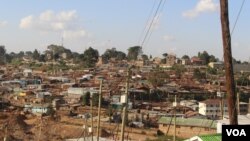Kenya on Friday recognized World Tuberculosis Day by releasing results of a TB study by the country's ministry of health — the first of its kind since Kenya's independence. TB remains high in Kenya, and experts say the country lags in the fight against the disease.
The survey represents a united front by many committed parties to determine the true burden of tuberculosis and how to best combat the fourth-leading cause of death in Kenya.
The survey is intended to provide an accurate estimate of Kenya's TB burden, determine existing challenges in delivering TB testing and treatment, and identify people with TB not yet detected by the National TB control program. It was conducted to inform the government on how to effectively respond to TB control.
More than 63,000 people across 45 counties in Kenya were screened for the survey and, for the first time, there is accurate data on TB's prevalence.
Dr. Enos Masini, the head of the National Tuberculosis, Leprosy and Lung disease program at the Ministry of Health, said the survey was driven by a need to know what the country was facing.
"We undertook to do this survey in the community to provide us with the exact data of the burden of the disease in Kenya, but also to go further and find out which groups of people are affected by the disease and what would be the best strategies for us to reach them," he said.
The report states that there are more TB cases in Kenya than previously estimated, with a TB prevalence of 558 per 100,000 people.
TB was found to be higher in men between the ages of 25 and 34 years, urban dwellers, and women over the age of 65.
The majority (83 percent) of TB cases were HIV negative, suggesting that broad efforts at controlling TB in people with and without HIV are needed.
"For a long time, the estimates that we have used to accurately determine the burden of tuberculosis has been provided by the World Health Organization," said Masini. "And this has been derived from the data we get from hospital records. We have always suspected that there could be a huge number of patients in the community that go untreated and undiagnosed and, therefore, fuel the transmission of the disease."
Now, with the findings, he said the government and various stakeholders can deal with the disease effectively.
"Now we are not groping in the dark," he said. "We know how much disease there is in this country. Secondly, we know that 40 percent of disease that occurs in this country remains undetected and untreated, and then we have a pretty good idea where people who are undetected, who are called missing TB cases, are."
Masini said this information will help with planning. "We can ... have strategic plans that really target people at most risk, people who are missed. And so we are able to find them and provide them with treatment."
The United States Agency for International Development (USAID) and the U.S. Department of Health and Human Services' Centers for Disease Control and Prevention (CDC) provided technical and scientific support to the government of Kenya in the design and implementation of the survey and $575,000 in funding to conduct it.
According to Kenya's National Tuberculosis, Leprosy and Lung Disease Program, the major factor responsible for the large TB disease burden is the concurrent HIV epidemic.
Other contributing factors include poverty and social deprivation that have led to a mushrooming of peri-urban slums between cities and the countryside, and limited access to general health care services.
The survey findings also reveal that the current practice of screening for TB symptoms and using microscopy as the only test misses many cases. Using GeneXpert, an innovative technology for the diagnosis of TB, has led to the detection of 78 percent of TB cases among those screened, making it a more reliable and efficient test.
A statement from the Cabinet secretary of Health, Dr. Cleopa Mailu, said in part "the government was committed to making TB diagnostics accessible" by expanding "the use of Chest X-rays to screen all persons presumed to have TB and make GeneXpert the first diagnostic test for all presumed TB cases."
The government also said that it would increase engagement with the private sector, carry out targeted approaches through community-based action, and improve community awareness of TB symptoms in an effort to make TB everyone's business.









